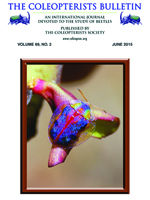Hydrophone recordings from three aquatic beetle species within the family Hydrophilidae, Berosus pantherinus (LeConte), Tropisternus blatchleyi (d'Orchymont), and Tropisternus collaris (F.), were used to create an automated identification program. The identification program was designed using digital signal processing techniques and is capable of identifying which species is present from hydrophone recordings alone. Using features based on the frequency content of each beetle call and background sounds in reference recordings, half-second segments of audio recordings were classified as a specific beetle species call, a general beetle distress call, or as noise. Classification accuracy ranged from 87.5% for reference recordings. Training calls had accuracies of 98% and above between beetle species and noise. The majority of beetle recordings in a mesocosm environment were classified correctly. Often, T. blatchleyi was false-positively identified in recordings with non-beetle background noises, such as frogs or traffic, suggesting similar active frequencies in the T. blatchelyi features and these noises. The use of digital signal processing to identify aquatic invertebrates by sound is a new technique that has potential uses in taxonomy, surveys, and long-term biomonitoring of aquatic systems by providing a hands-free method of detection, and eventually identification, in the field.
How to translate text using browser tools
18 June 2015
Identification of Sound-Producing Hydrophilid Beetles (Coleoptera: Hydrophilidae) in Underwater Recordings Using Digital Signal Processing
Nissa Wilson,
Michael B. Flinn,
Brian West,
James Hereford
ACCESS THE FULL ARTICLE

The Coleopterists Bulletin
Vol. 69 • No. 2
June 2015
Vol. 69 • No. 2
June 2015
aquatic
behavior
bioacoustics
hydrophone
sound production
stridulation




